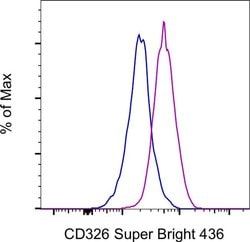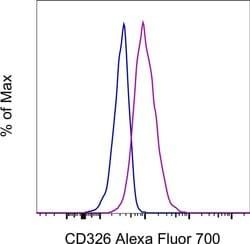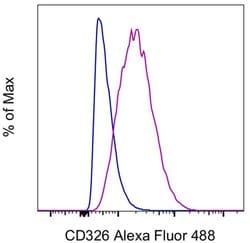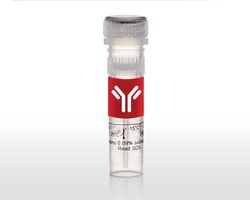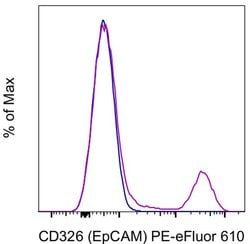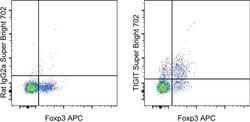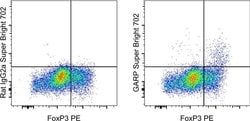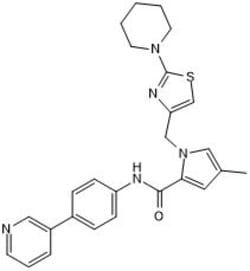CD326 (EpCAM) Monoclonal Antibody (1B7), Super Bright™ 702, eBioscience™, Invitrogen™
Manufacturer: Invitrogen
Select a Size
| Pack Size | SKU | Availability | Price |
|---|---|---|---|
| Each of 1 | 67-932-642-Each-of-1 | In Stock | ₹ 34,087.00 |
67-932-642 - Each of 1
In Stock
Quantity
1
Base Price: ₹ 34,087.00
GST (18%): ₹ 6,135.66
Total Price: ₹ 40,222.66
Antigen
CD326 (EpCAM)
Classification
Monoclonal
Concentration
5 μL/Test
Formulation
PBS with BSA and 0.09% sodium azide, pH 7.2
Gene Accession No.
P16422
Gene Symbols
EPCAM
Purification Method
Affinity chromatography
Regulatory Status
RUO
Gene ID (Entrez)
4072
Content And Storage
4° C, store in dark, DO NOT FREEZE!
Form
Liquid
Applications
Flow Cytometry
Clone
1B7
Conjugate
Super Bright 702
Gene
EPCAM
Gene Alias
adenocarcinoma-associated antigen, CD326, cell surface glycoprotein Trop-1, DIAR5, EGP, EGP-2, EGP314, EGP40, EPCAM, Ep-CAM, EpCAM1, epithelial cell adhesion molecule, Epithelial cell surface antigen, Epithelial glycoprotein, Epithelial glycoprotein 314, ESA, GA733-2, gp40, hEGP314, HNPCC8, human epithelial glycoprotein-2, KS 1/4 antigen, KS1/4, KSA, Ly74, lymphocyte antigen 74, M1S2, M4S1, major gastrointestinal tumor-associated protein GA733-2, mEGP314, membrane component, chromosome 4, surface marker (35kD glycoprotein), MIC18, MK-1, panepithelial glycoprotein 314, protein 289A, Protein D5.7A, Tacsd1, Tacstd1, TROP1, Trop-1 protein, Tumor-associated calcium signal transducer 1
Host Species
Mouse
Quantity
100 Tests
Primary or Secondary
Primary
Target Species
Human
Product Type
Antibody
Isotype
IgG1 κ
Description
- Description: EpCAM (Epithelial cell adhesion molecule, CD326, KSA, TROP1) is a 40 kD cell-surface adhesion molecule participating in homophilic, calcium-independent cell-cell interactions
- EpCAM is a type-I transmembrane protein, and is expressed primarily on the basolateral surface of most epithelia
- Although normal epithelia express low levels of EpCAM, increased expression has been correlated with increased proliferation and progression to a mesenchymal phenotype
- EpCAM has also been used as a diagnostic marker on circulating metastatic carcinoma cells, while cancer cells of non-epithelial origin do not express EpCAM
- Applications Reported: This 1B7 antibody has been reported for use in flow cytometric analysis
- Applications Tested: This 1B7 antibody has been pre-diluted and tested by flow cytometric analysis of A549 cells
- This may be used at 5 μL (0.5 μg) per test
- A test is defined as the amount (μg) of antibody that will stain a cell sample in a final volume of 100 μL
- Cell number should be determined empirically but can range from 10^5 to 10^8 cells/test
- Super Bright 702 is a tandem dye that can be excited with the violet laser line (405 nm) and emits at 702 nm
- We recommend using a 710/50 bandpass filter
- Please make sure that your instrument is capable of detecting this fluorochrome
- When using two or more Super Bright dye-conjugated antibodies in a staining panel, it is recommended to use Super Bright Complete Staining Buffer (Product No
- Ep-CAM (epithelial adhesion molecule, epithelial specific antigen, ESA) is a transmembrane glycoprotein expressed in the epithelium with a molecular weight of approximately 40 kDa, which functions as an epithelial cell adhesion molecule
- Ep-CAM functions as a homotypic calcium-independent cell adhesion molecule, and has a direct impact on cell cycle, proliferation and metabolism of epithelial cells and fibroblasts due to its ability to rapidly induce the proto-oncogene c-myc and the cell cycle regulating genes cyclin A and E
- Ep-CAM mediates Ca2+-independent homotypic interactions
- Formation of Ep-CAM-mediated adhesions have a negative regulatory effect on adhesions mediated by classic cadherins, which may have strong effects on the differentiation and growth of epithelial cells
- Ep-CAM overexpression was suggested to be associated with enhanced epithelial proliferation
- Ep-CAM is highly expressed in human carcinomas, and is a marker for tumors of epithelial lineage
- Ep-CAM is expressed on baso-lateral cell surface in most simple epithelia and many carcinoma types
- Also, Ep-CAM reportedly distinguishes adenocarcinomas from pleural mesotheliomas.
